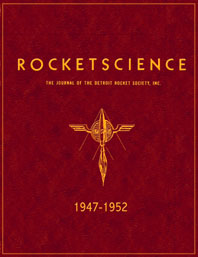$49.95 Go to item 66B on the shopping cart.
| Rocket Science The Journal of the Detroit Rocket Society During World War II Alfred Zaehringer witnessed the awesome power of the Nazi's V-2 rocket as it levelled homes and businesses in London, then in 1945 he was once again on hand as V-1 and V-2 missiles were used against the Allied forces at Remagen, site of the famous bridge crossing over the Rhine into Germany. During these final engagements of World War II Zaehringer would also witness the first jet and rocket aircraft as they struggled to protect Germany in the last few months of the war. On returning to his home town of Detroit Zaehringer decided to form a society dedicated to the study of these new technologies. To that end he contacted the American Rocket Society and tried to find like-minded individuals in his local area. Ultimately Zaehringer was able to harness a membership for his new society that included some of the greatest talents of early rocketry. Contributors to RocketScience included Professor Hermann Oberth (one of the fathers of rocketry), Krafft Ehricke (designer of the Centaur liquid hydrogen stage), Eugen Sanger (father of the rocket plane), Heinz Koelle (Director of Advanced projects for NASA) and ex-Peenemunde engineer Hans Kaiser who gives an insiders view of life at the infamous Nazi rocket facility. Zaehringer himself would go on to become chief test engineer at the Thiokol Chemical Company (which would later merge with Reaction Motors and build the solid rockets for the Space Shuttle.) His career would also include working on the advanced Saturn V. He has written books in rocketry since the 1950s, his latest book "Rocket Science" released in 2004 is named after the phrase he coined in 1947 for the enclosed journal. The Journal of the Detroit Rocket Society is an obscure rarity of rocket history which has never been reprinted for over 50 years, until now, thanks to Alfred Zaehringer, who over sixty years (!) later is still actively pushing space flight. This book will only be produced in extremely limited quantities. It is 81/2 by 11 inches and 552 pages of photo facsimiles of every edition of the Journal from 1947-1952. It features unique material by Krafft Ehricke, Hermann Oberth, Eugen Sanger, Heinz Koelle and more. |
|
